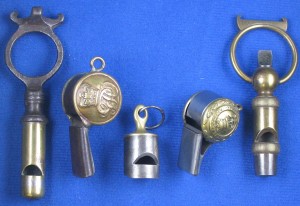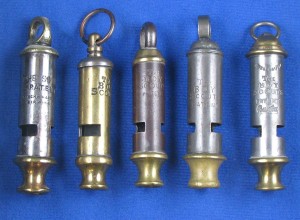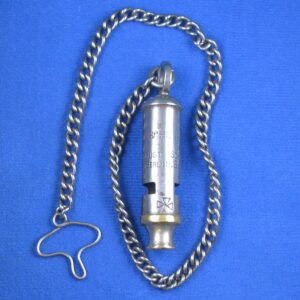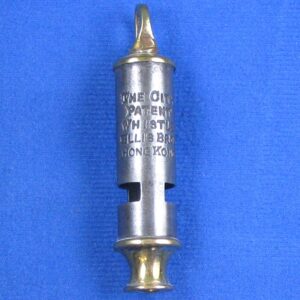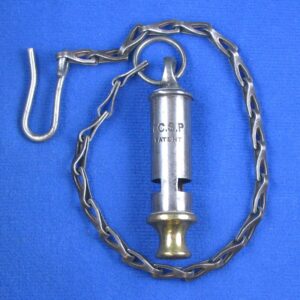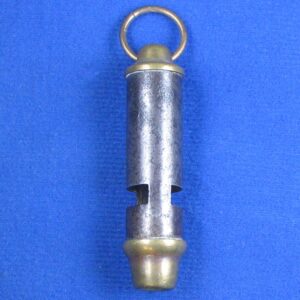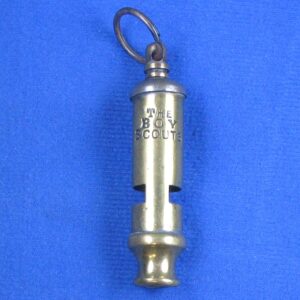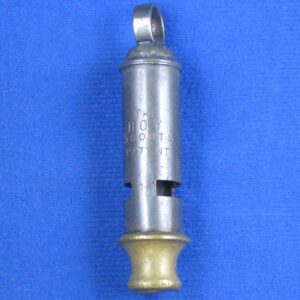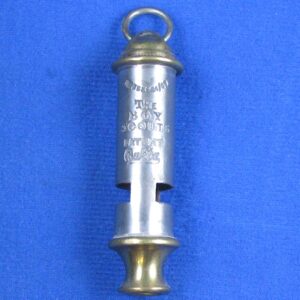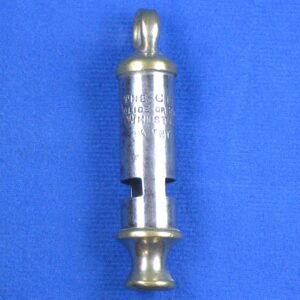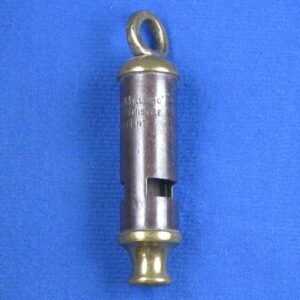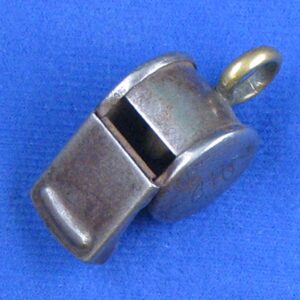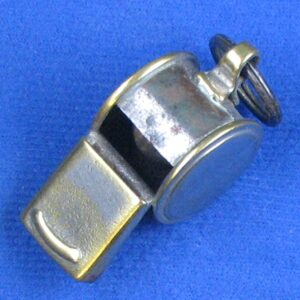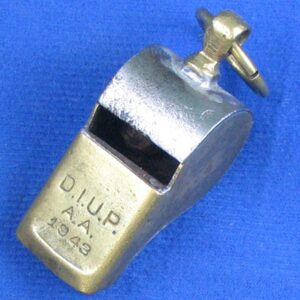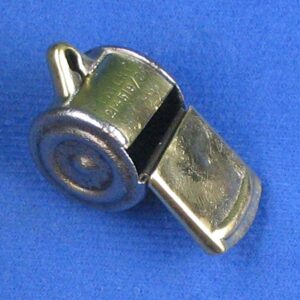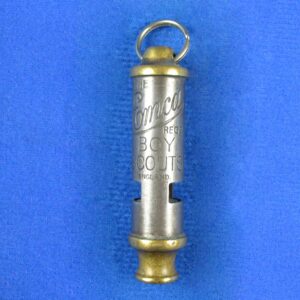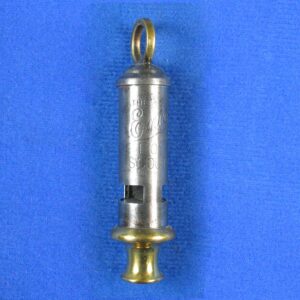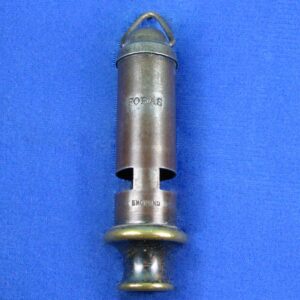Spotlight > Whistle Categories > Steel & Brass > 036
As this interesting and growing hobby expands, more areas of collecting emerge. We would like to introduce an area of whistles long neglected or perhaps merely overlooked.
This SPOTLIGHT focuses on the use of steel and brass in combination, in the manufacture of whistles. The period is circa world war one, till approximately world war two – 30 years or less
Perhaps motivated by the desire to save expenses, they at first appear made for strength and durability and so steel was inserted. Eventually arose the use of certain ( and not specific ) parts made with steel instead of brass and in the process this has created some beautiful whistles seen fully when the plating or finish has eroded.
At times the whistle was oxidized over with a painting process, yet when this too has eroded away it reveales a patina and texture that contrasts and at the same time highlights the brass/steel combinations. The dark golden almost brown patina of the brass goes well with the shiney to coal tint patina of the steel.
When first looking it appears that there are only a few to find. At the same time it would seem that they are mostly tube shaped. Then one looks back in time at all the button whistles. Also the extractor whistles, especially in the USA and France. Now we see there is a wide variety of whistles to be found of the many shaped models and interestingly there are more escargots then one would imagine. They were made after the 1930s following the war years era.
Hudson and DeCourcy make up most of the whistles found thus far. However India, the USA and Bulgaria are entered in. 20 different tube shaped ones have been recorded and four escargots to date, more if you count model sizes. We will continue to add to this SPOTLIGHT as others arise. Along with these are several extractors, rounds and button whistles.
First let’s look at some variety to see how versatile these manufacturers have been…
Side by side one really gets the impact of how strikingly set apart they are as a group to collect and study and how really beautiful they can be.
Buttons have set the bar from early in the 19th century. These were made by very rustic means ( and are found with quite a bit of rust ), yet sometimes were made with craftsmanship. So at times there were higher quality whistles using nickle silver instead of steel. Extractors too were produced utilizing very srtong steel for the carriage key, extractor teeth and so on.
Later the WW1 sought after cost savings were seen in the tube shaped whistles by DeCourcy and Hudson. Any piece could be substituted for brass though, brass being the choice for corrosion resistance ( or better yet, nickel silver )
We see the creativity and contrasts of a variety of tops and different parts interchanged, thus shown is without the further accompaniment of steel or brass chains or even a combination within.
Now let’s zoom in on some singular whistles starting with a Hudson made whistle from Germany. Complete with steel chain it really stands out. The simplicity of the brass mouthpiece cries out for more brass, but looks terrific as is.
Finding a Hudson of this model is rare. Usually they are German made and entirely brass. Again this one is circa WW1 as can be seen from the 2 piece top. However it is more solidly attached than normal.
The tines are entirely Hudson though.
Next is a very heavy well made DeCourcy with patent dated 1906. So this would precede WW1.
Perhaps just motivated by saving expenses to compete with Hudson. Alfred DeCourcy was the only major player left on the field in manufacturing whistles besides Hudson at this time.
The cast top and rolled mouthpiece are both brass.
The following has a cast steel top instead and a beautiful steel almost AV link chain.
Next is a simple Hudson top and mouthpiece, but unusual in shape.
Probably dated close to halfway between WW1 and WW11, we can see the England stamp.
If we drop back a bit to the patented pillar top of Hudson’s scout whistle we are dated right in the first war years.
The pillar is indeed brass yet the top cap is steel, but with the mouthpiece that is machined rolled brass and the body is all brass.
Now comes a DeCourcy circa 1915 patented top that is distinctively his. The body was left rusty. Almost has a chocolate patina.
Steel top ring, brass top cap and brass mouthpiece set against a steel body.
The next is a DeCourcy scout that is rare. The top ring is flat and steel along with the body, yet the mouthpiece is brass.
In 1909 Alfred also patented the distinctive scout hat top and typically they are oxidized over. When revealed the whistle is a remarkable contrast.
Next is another distinctive top by Alfred DeCourcy and many times overlooked whistle. Even more eventful is the brass and steel underneath the plating that one usually sees until once the plating has worn off.
His use of the rounded edges on top goes well with this Police/Fire mouthpiece. The steel body is simple and side by side with others is a fine variation.
Not to be out done is Hudson, circa 1915. Their 2 piece top is distinctive. Also both pieces are brass to match the machined rolled mouthpiece.
Indeed no cast brass mouthpieces have been found with steel combination whistles to date.
Now we shift to escargots, this one being a soccer whistle from Bulgaria. Only the ring is brass and the rest steel.
Following up is a DeCourcy circa 1918. It is made to a patent for the barrel ends wrapping around.
Mostly brass with the middle being steel and with a complimentary steel split ring, it is set off well.
This heavy escargot is dated circa 1940s and was found entirely painted. It is made to Hudson’s 1891 patent.
The tooth grip is pressed and not hand filed like so many ones during this time. However the knop is entirely hand filed of brass.
Lastly we close with a small escargot made by Hudson, very nice combination of steel and brass.
It has the innovative V top patented in 1924. Brass where needed and sides of steel to save some on production.
Addendum:
There are more appearing all the time of steel and brass ( now just plain noticed ). One can look for all the models of EMCA tube shaped whistles for instance .
Another aspect is that steel and brass whistles are still very inexpensive to collect which adds to the joy of whistle study.
– TWG
Posted November 5, 2014
